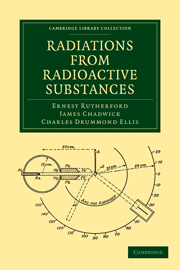Book contents
- Frontmatter
- Contents
- LIST OF PLATES
- Preface
- Chap. I Radioactive Transformations
- Chap. II The α Rays
- Chap. III Absorption of the α Rays
- Chap. IV Some Properties of the α Particle
- Chap. V Theories of Absorption of α Rays
- Chap. VI Secondary Effects produced by α Rays
- Chap. VII General Properties of the Radiations
- Chap. VIII The Scattering of α and β Particles
- Chap. IX The Collisions of α Particles with Light Atoms
- Chap. X The Artificial Disintegration of the Light Elements
- Chap. XI The Radioactive Nuclei
- Chap. XII β Ray and γ Ray Spectra
- Chap. XIII The Disintegration Electrons
- Chap. XIV The Passage of β Particles through Matter
- Chap. XV The Scattering and Absorption of γ Rays
- Chap. XVI Intensity Problems connected with the Emission of γ Rays
- Chap. XVII Atomic Nuclei
- Chap. XVIII Miscellaneous
- Appendix
- Subject Index
- Index of Names
- Plate section
Chap. IX - The Collisions of α Particles with Light Atoms
Published online by Cambridge University Press: 07 September 2010
- Frontmatter
- Contents
- LIST OF PLATES
- Preface
- Chap. I Radioactive Transformations
- Chap. II The α Rays
- Chap. III Absorption of the α Rays
- Chap. IV Some Properties of the α Particle
- Chap. V Theories of Absorption of α Rays
- Chap. VI Secondary Effects produced by α Rays
- Chap. VII General Properties of the Radiations
- Chap. VIII The Scattering of α and β Particles
- Chap. IX The Collisions of α Particles with Light Atoms
- Chap. X The Artificial Disintegration of the Light Elements
- Chap. XI The Radioactive Nuclei
- Chap. XII β Ray and γ Ray Spectra
- Chap. XIII The Disintegration Electrons
- Chap. XIV The Passage of β Particles through Matter
- Chap. XV The Scattering and Absorption of γ Rays
- Chap. XVI Intensity Problems connected with the Emission of γ Rays
- Chap. XVII Atomic Nuclei
- Chap. XVIII Miscellaneous
- Appendix
- Subject Index
- Index of Names
- Plate section
Summary
§ 56. In the previous chapter those experiments on the scattering of α particles in passing through matter were described which confirm the essential assumption of the present theory of atomic structure, that the atoms of matter contain a positively charged nucleus having practically the whole mass of the atom associated with it. The experiments showed that the magnitude of the positive charge of the nucleus was fixed by the atomic number of the atom, or its position in the ascending series of the chemical elements. In the collisions examined in these experiments, in which no elements of smaller atomic number than copper were investigated, the atomic nucleus and the α particle behaved as point charges repelling each other with a force varying inversely as the square of the distance between them.
It is to be anticipated that divergences from the Coulomb law of force would appear when the collisions between the atomic nucleus and the α particle are sufficiently close, for the nuclei are generally supposed to have a complex structure and to be built up in some way from two common units, the electron and the hydrogen nucleus or proton. Since the closest distance of approach to a nucleus of an α particle of given energy is proportional to the charge of the nucleus, it is in the collisions of fast α particles with the nuclei of the lighter elements that deviations from the normal law of force might be expected to be most readily discovered.
- Type
- Chapter
- Information
- Radiations from Radioactive Substances , pp. 240 - 280Publisher: Cambridge University PressPrint publication year: 2010First published in: 1930



